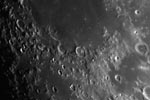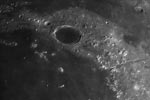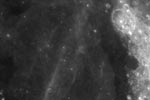|
These images are convincing evidence that on an average night, high resolution imagery can be done on the moon and bright planets if the images are taken with a careful methodology, and processing is done accordingly. These images not only compare favorably, but in about half the cases exceed the resolution of the photographs in Jean Dragesco's book - High Resolution Astrophotography. This book represents the best film based images, before CCDs became available to amateurs. A good comparison is The shot of the Plato-Alpine Valley area, the tiny cleft running along the center of the valley is .23 to .33 arcsec in width. The feature is barely seen in Don Parkers film image on page 94 yet is clearly visible in my image below (5th image) with the seeing averaging 2.2 arcseconds over most of the evening. Using the CCD's ability to take fast exposures and freeze the seeing, combined with the proper processing brought out such small details. Processing. Ten to twenty images of each field were taken with my 12.5 inch f/5 newtonian with a 2x televue barlow for projection. The exposure times were a brief .1 second with my ST7E, and a neutral density filter was used to dim the moon to tolerable levels. Only one out of ten or more were suitable for processing. Most were blurred badly by seeing, including rapid motion type smearing from atmospheric turbulence. The one clear image was then calibrated in Maixm, and brought into AIP for deconvolution. 10 iterations of Van Cittert with a carfully chosen radius was applied to remove the seeing blur. The images were then brought into Photoshop6, and because the deconvolution process removes most of the gradients from the image similar to a high pass filter, the gradient from the lunar terminator was added back in to give the moon a photographic appearance. This was done by laying the original image, unprocessed over the final image. The top layer was set to soft lighting, at 75 percent to add back in the gradient. Here are the final images. They are as film like as I can possibly make them, I hope you enjoy them! Click on the thumbnails for the full size image. Clavius Schiller and Hainzel Mare Humorum and Vitello Gassendi and Mare Humorum Plato and the Alpine Valley Posidonius and Mare Serenitatis Instrument: 12.5" f/5 Home made Newtonian with 2x Televue Barlow Platform: Astrophysics 1200 QMD CCD Camera: SBIG ST7E w/Enhanced Cooling Exposure: L = .1s Filters: 2.0 ND Location: Payson, Arizona Elevation: 5150 ft. Sky: Seeing FMHW = 2.2 arcsec, Transparency 6/10 Outside Temperature: -5 C CCD Temperature: -35 C Processing: Maxim DL, Photoshop, AIP4WIN.
|
||
|
|
||
|
FastCounter by bCentral |





